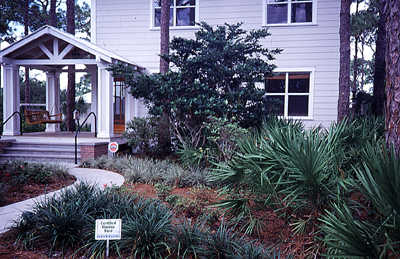
by Rick O'Connor | Jun 8, 2018
We have been posting articles discussing some of the issues our estuaries are facing; this post will focus on one of the things you can do to help reduce the problem – a Florida Friendly Yard.
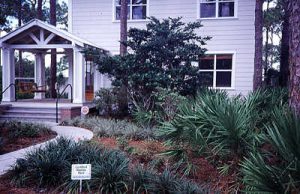
Florida Friendly Landscaping saves money and reduces our impact on the estuarine environment.
Photo: UF IFAS
The University of Florida IFAS developed the Florida Friendly Landscaping Program. It was developed to be included in the Florida Yards & Neighborhoods (FYN) program, HomeOwner and FYN Builder and Developer programs, and the Florida-Friendly Best Management Practices for Protection of Water Resources by the Green Industries (GI-BMP) Program in 2008.
A Florida Friendly Yard is based on nine principals that can both reduce your impact on local water quality but also save you money. Those nine principals are:
- Right Plant, Right Place – We recommend that you use native plants in the right location whenever possible. Native plants require little fertilizer, water, or pesticides to maintain them. This not only reduces the chance of these chemicals entering our waterways but also saves you money. The first step in this process is to have your soil tested at your local extension office. Once your soil chemistry is known, extension agents can do a better job recommending native plants for you.
- Water Efficiently – Many homeowners in the Florida panhandle have irrigation systems on timers. This makes sense from a management point of view but can lead to unnecessary runoff and higher water bills. We have all seen sprinkler systems operating during rain events – watering at that time certainly is not needed. FFY recommends you water only when your plants show signs of wilting, water during the cooler times of day to reduce evaporation of your resource, and check system for leaks periodically. Again, this helps our estuaries and saves you money.
- Fertilize Appropriately – No doubt, plants need fertilizer. Water, sunlight, and carbon dioxide produce the needed energy for plants to grow, but it does not provide all of the nutrients needed to create new cells – fertilizers provide needed those nutrients. However, plants – like all creatures – can only consume so much before the remainder is waste. This is the case with fertilizers. Fertilizer that is not taken up by the plant will wash away and eventually end up in a local waterway where it can contribute to eutrophication, hypoxia, and possible fish kills. Apply fertilizers according to UF/IFAS recommendations. Never fertilize before a heavy rain.
- Mulch – In a natural setting, leaf litter remains on the forest floor. The environment and microbes, recycling needed nutrients within the system, break down these leaves. They also reduce the evaporation of needed moisture in the soil. FFY recommends a 2-3” layer of mulch in your landscape.
- Attract Wildlife – Native plants provide habitat for a variety of local wildlife. Birds, butterflies, and other creatures benefit from a Florida Friendly Yard. Choose plants with fruits and berries to attract birds and pollinators. This not only helps maintain their populations but you will find enjoyment watching them in your yard.
- Manage Yard Pests Responsibly – This is a toughie. Once you have invested in your yard, you do not want insect, or fungal, pests to consume it. There is a program called the Integrated Pest Management Program (IPM) that is recommended to help protect your lawn. The flow of the program basically begins with the least toxic form of pest management and moves down the line. Hopefully, there will not be a need for strong toxic chemicals. Your local county extension office can assist you with implementing an IPM program.
- Recycle – Return valuable nutrients to the soil and reduce waste that can enter our waterways by composting your turfgrass clippings, raked leaves, and pruned plants.
- Reduce Stormwater Runoff – ‘All drains lead to the sea’ – this line from Finding Nemo is, for the most part, true. Any water leaving your property will most likely end in a local waterway, and eventually the estuary. Rain barrels can be connected to rain gutters to collect rainwater. This water can be used for irrigating your landscape. I know of one family who used it to wash their clothes. Rain barrels must be maintained properly to not produce swarms of mosquitos, and your local extension office can provide you tips on how to do this. More costly and labor intensive, but can actually enhance your yard, are rain gardens. Modifying your landscape so that the rainwater flows into low areas where water tolerant plants grow not only reduces runoff but also provides a chance to grow beautiful plants and enhance some local wildlife.
- Protect the Waterfront – For those who live on a waterway, a living shoreline is a great way to reduce your impact on poor water quality. Living shorelines reduce erosion, remove pollutants, and enhance fisheries – all good. A living shoreline is basically restoring your shoreline to a natural vegetative state. You can design this so that you still have water access but at the same time help reduce storm water runoff issues. Planting below the mean high tide line will require a permit from the Florida Department of Environmental Protection, since the state owns that land, and it could require a breakwater just offshore to help protect those plants while they are becoming established. If you have questions about what type of living shoreline you need, and how to navigate the permit process, contact your local county extension office.
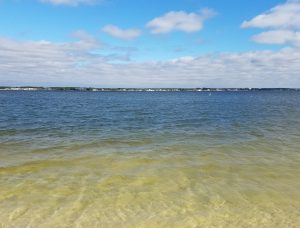
Santa Rosa Sound
Photo: Dr. Matt Deitch
These nine principals of a Florida Friendly Yard, if used, will go a long way in reducing our communities’ impact on the water and soil quality in our local waterways. Read more at http://fyn.ifas.ufl.edu/about.htm.
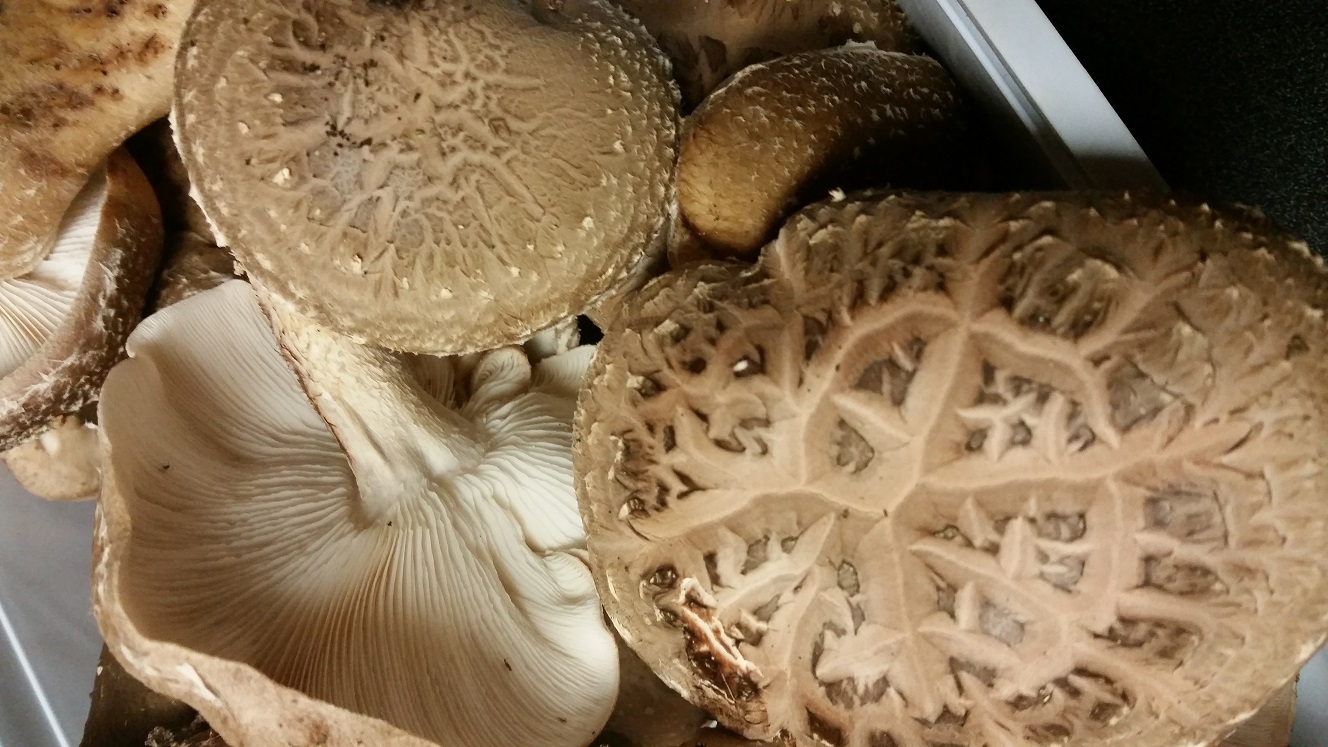
by Erik Lovestrand | Jun 8, 2018
Have you ever eaten a wild mushroom and then wondered afterwards if you might have made a mistake? If you are prone to forage outdoors for tasty treats from nature, I’ll bet you have. The problem is, unless you are harvesting one of a few “foolproof” species of edible fungi, positive identification can be very challenging. Oft-times wild mushroom harvesters take a notion to branch out and seek new varieties that are outside of the identification capabilities of the novice mycologist. This is where folks begin treading on dangerous ground and may be at risk for gastrointestinal distress;

Properly inoculated shiitake logs can be quite productive
with symptoms that may range from a mild upset stomach to permanent damage or death.
Yes, death!
Everyone has heard about poisonous mushrooms but few people realize that some of the deadliest species are look-alikes for some of the tastiest species. And you would not be able to distinguish the difference by nibbling a sample. Even a small sample of some of the “bad actors” can be lethal, leading to painful symptoms and organ failure. If this scares you out taking a risk then this article has served a good purpose.
If you wish to enjoy a safe, tasty experience with a highly-prized mushroom species, just take up the hobby of growing your very own shiitake mushrooms. Shiitake comes from the root Japanese “shii” (meaning oak) and “take” (for mushroom). Shiitake mushrooms are a billion dollar industry in Asia with 92% of the world production coming from Japan. Many culinary and medical uses have been identified. This species was only available as dried mushrooms in the US until 1972 but with the removal of a ban on importing live fungi a commercial industry has blossomed.
Hardwood logs are the key, with oak being a preferred tree species. There are six considerations if you are to be successful:
1. You must acquire living Shiitake inoculum (the mycelial or rooting stage) already growing on a wood medium, usually hardwood dowels or sawdust (internet search will yield many providers).
2. Proper cutting and handling of the logs to be inoculated is important. Cut trees close to the time of inoculation (2 weeks max.), 4-8 inch diameter and 3-4 feet long.
3. Inoculate by drilling holes in the logs, inserting the living inoculum/spawn and seal the holes with melted wax to retain moisture. A single log may have 30-40 holes drilled in it.
4. Place logs in a shady/moist environment (i.e. under the canopy in a woodlot with at least 75% shade).
5. Maintain logs by wetting during dry spells. A sprinkler or mister run for a couple of hours a day works well.
6. Proper harvesting and storage is most important and information is available in many places online.
Shiitake fruiting is usually triggered by changes in temperature and humidity so spring and fall are key times to check your logs. It does not take long for a mushroom to go from the early “pinning” stage to mature, so weekly checks are advised. Significant tropical weather events will also stimulate fruiting. Logs produce mushrooms for at least two years, until the nutrients in the wood are used up.
Don’t be in a hurry though, as the full colonization of the log by the mushroom mycelium will take up to 9 months before mushrooms begin to appear. Remember, beware the risks of harvesting wild fungi. A small-scale shiitake growing operation is a safe alternative for getting your “mushroom-fix.” Also, be ready to compete with a squirrel or two for your crop as they know a good thing when they see it too.

by Les Harrison | Mar 18, 2018
It is easy to notice the display of bright pink puffs erupting on low-growing trees along roadsides. This attractive plant is the Mimosa tree, Albizia julibrissin.
These once popular small trees are commonly found in the yards of older homes in Florida where the display of prolific blooms starts up as the weather warms.
This species is also classified as invasive native to southwest and eastern China, not Florida. Many Florida residents may not realize this tantalizing beauty is actually an aggressive invader in disguise.
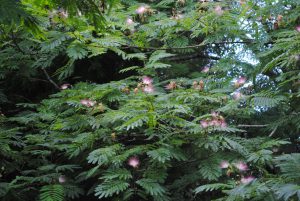
The beautiful mimosa is found throughout the Florida panhandle.
Photo: Les Harrison
It has spread from southern New York west to Missouri south to Texas. It is even considered an invasive species in Japan.
Worse yet, mimosas are guilty of hosting a fungal disease, Fusarian, which will negatively affect many ornamental and garden plants. Some palms as well as a variety of vegetables will succumb to this pathogen.
In natural areas the invader will disrupt not only other plants, but also the birds, mammals, amphibians, and insects which depend on the displaced plants for food, shelter and habitat. Other negative traits include the disruption of water flow and aiding the incidence of wildfires.
In natural areas, mimosas tend to spread into dense clumps blocking the light to native plants which prevents them from growing. They are prominent along the edges of woods and wetland areas where seeds scatter easily and take advantage of sheltered, sunlit spots.
Mimosa tree seeds can stay viable for many years in the soil. These seeds will float without damage to their germination potential until they wash ashore to colonize a new site.
Additionally, Mimosa tree seeds are attractive to wildlife. One tree in a yard can infest many acres with the aid of birds and small mammals.
Cut or wind snapped trees quickly regrow from the stump, making this one invader that is difficult to eradicate.
Fortunately, there are a variety of small trees which can replace the Mimosa tree in home landscapes. Many are attractive, but without the unrelenting need to populate the entire subdivision.
This is a beauty-and-the-beast combo tree with too many problems to compensate for its looks.
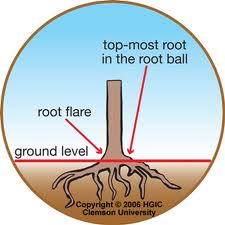
by Sheila Dunning | Jan 19, 2018
We plant trees with the intention of them being there long after we are gone. However, m any trees and shrubs fail before ever reaching maturity. Often this is due to improper installation and establishment. Research has shown that there are techniques to improve survivability. Before digging the hole:
any trees and shrubs fail before ever reaching maturity. Often this is due to improper installation and establishment. Research has shown that there are techniques to improve survivability. Before digging the hole:
- Look up. If there is a wire, security light, or building nearby that could interfere with proper development as it grows, plant elsewhere.
- Dig a shallow planting hole as wide as possible. Shallow is better than deep! Many people plant trees too deep. A hole about one-and-one-half the diameter of the width of the root ball is recommended. Wider holes should be used for compacted soil and wet sites. In most instances, the depth of the hole should be LESS than the height of the root ball, especially in compacted or wet soil. If the hole was inadvertently dug too deep, add soil and compact it firmly with your foot. .
- Find the point where the top-most root emerges from the trunk. If this is buried in the root ball then remove enough soil from the top so the point where the top-most root emerges from the trunk is at the surface. Burlap on top of the ball may have to be removed to locate the top root.
- Slide the plant carefully into the planting hole. To avoid damage when setting a large tree in the hole, lift the tree with straps or rope around the root ball, not by the trunk. Special strapping mechanisms need to be constructed to carefully lift trees out of large containers.
- Position the plant where the top-most root emerges from the trunk slightly above the landscape soil surface. It is better to plant a little high than to plant it too deep. Remove most of the soil and roots from on top of the root flare and any growing around the trunk or circling the root ball. Once the root flare is at the appropriate depth, pack soil around the root ball to stabilize it. Soil amendments are usually of no benefit. The soil removed from the hole and from on top of the root ball makes the best backfill unless the soil is terrible or contaminated. Insert a square-tipped balling shovel into the root ball tangent to the trunk to remove the entire outside periphery. This removes all circling and descending roots on the outside edge of the root ball.
- Straighten the plant in the hole. Before you begin backfilling have someone view the plant from two directions perpendicular to each other to confirm that it is straight. Break up compacted soil in a large area around the plant provides the newly emerging roots room to expand into loose soil. This will hasten root growth translating into quicker establishment Fill in with some more backfill soil to secure the plant in the upright position.
- Remove synthetic materials from around trunk and root ball. Synthetic burlap needs to be completely removed from the root ball; treated burlap can be left in place. String, strapping, plastic, and other materials that will not decompose and must be removed from the trunk at planting. Remove the wire above the soil surface from wire baskets before backfilling.
- Apply a 3-inch-layer of mulch. To retain moisture and suppress weeds cover the outer half of the root ball with an organic mulch. Do not cover the stem of the plant or the connecting root flare.
- Water consistently until established. For nursery stock less than 2-inches in caliper, this will require every other day for 2 months, followed by weekly 3-4 months. At each irrigation, apply 2 to 3 gallons of water per inch trunk caliper directly over the root ball. Never add irrigation if the ground is saturated.
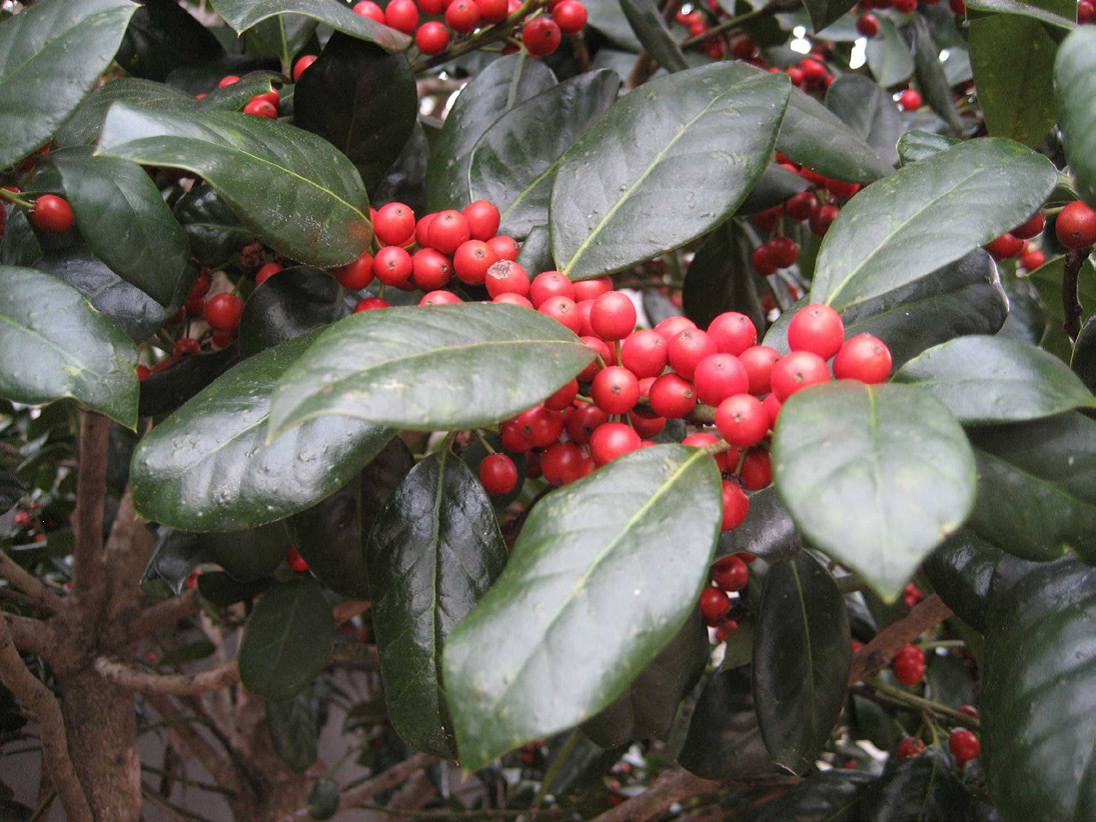
by Sheila Dunning | Dec 15, 2017
According to Druid lore, hanging the plant in homes would bring good luck and protection. Holly was considered sacred because it remained green and strong with brightly colored red berries no matter how harsh the winter. Most other plants would wilt and die.
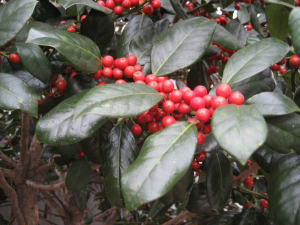 Later, Christians adopted the holly tradition from Druid practices and developed symbolism to reflect Christian beliefs. Today, the red berries are said to represent the blood that Jesus shed on the cross when he was crucified. Additionally, the pointed leaves of the holly symbolize the crown of thorns Jesus wore on his head.
Later, Christians adopted the holly tradition from Druid practices and developed symbolism to reflect Christian beliefs. Today, the red berries are said to represent the blood that Jesus shed on the cross when he was crucified. Additionally, the pointed leaves of the holly symbolize the crown of thorns Jesus wore on his head.
Several hollies are native to Florida. Many more are cultivated varieties commonly used as landscape plants. Hollies (Ilex spp.) are generally low maintenance plants that come in a diversity of sizes, forms and textures, ranging from large trees to dwarf shrubs.
The berries provide a valuable winter food source for migratory birds. However, the berries only form on female plants. Hollies are dioecious plants, meaning male and female flowers are located on separate plants. Both male and female hollies produce small white blooms in the spring. Bees are the primary pollinators, carrying pollen from the male hollies 1.5 to 2 miles, so it is not necessary to have a male plant in the same landscape.
Several male hollies are grown for their compact formal shape and interesting new foliage color. Dwarf Yaupon Hollies (Ilex vomitoria ‘Shillings’ and ‘Bordeaux’) form symmetrical spheres without extensive pruning. ‘Bordeaux’ Yaupon has maroon-colored new growth. Neither cultivar has berries.
Hollies prefer to grow in partial shade but will do well in full sun if provided adequate irrigation. Most species prefer well-drained, slightly acidic soils. However, Dahoon holly (Ilex cassine) and Gallberry (Ilex glabra) naturally occurs in wetland areas and can be planted on wetter sites.
Evergreen trees retain leaves throughout the year and provide wind protection. The choice of one type of holly or another will largely depend on prevailing environmental conditions and windbreak purposes. If, for example, winds associated with storms or natural climatic variability occur in winter, then a larger leaved plant might be required.
The natives are likely to be better adapted to local climate, soil, pest and disease conditions and over a broader range of conditions. Nevertheless, non-natives may be desirable for many attributes such as height, growth rate and texture but should not reproduce and spread beyond the area planted or they may become problematic because of invasiveness.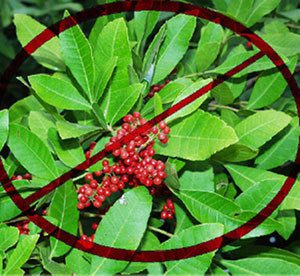
There is increasing awareness of invasiveness, i.e., the potential for an introduced species to establish itself or become “naturalized” in an ecological community and even become a dominant plant that replaces native species. Tree and shrub species can become invasive if they aggressively proliferate beyond the windbreak. At first glance, Brazilian pepper (Schinus terebinthifolius), a fast-growing, non-native shrub that has a dense crown, might be considered an appropriate red berry producing species. However, it readily spreads seed disbursed by birds and has invaded many natural ecosystems. Therefore, the Florida Department of Environmental Protection has declared it illegal to plant this tree in Florida without a special permit. Consult the Florida Exotic Pest Plant Council’s Web page (www.fleppc.org) for a list of prohibited species in Florida.
For a more comprehensive list of holly varieties and their individual growth habits refer to ENH42 Hollies at a Glance: http://edis.ifas.ufl.edu/mg021
by Erik Lovestrand | Feb 27, 2017
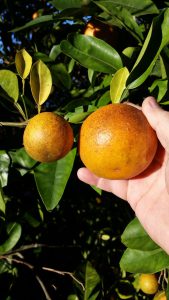
Fruits on HLB infected trees ripen prematurely, are small, and often drop from tree. Photo credit: Erik Lovestrand
If we look at the big picture when it comes to invasive species, some of the smallest organisms on the planet should pop right into focus. A microscopic bacterium named Candidatus Liberibacter asiaticus, the cause of Citrus Greening (HLB), has devastated the citrus industry worldwide. This tiny creature lives and multiplies within the phloem tissue of susceptible plants. From the leaves to the roots, damage is caused by an interruption in the flow of food produced through photosynthesis. Infected trees show a significant reduction in root mass even before the canopy thins dramatically. The leaves eventually exhibit a blotchy, yellow mottle that usually looks different from the more symmetrical chlorotic pattern caused by soil nutrient deficiencies.
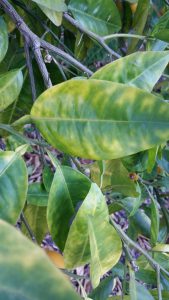
HLB, referred to as “Yellow Dragon” in China, causes an asymmetrical pattern of chlorosis in citrus leaves. Photo credit: Erik Lovestrand
One of the primary vectors for the spread of HLB is an insect called the Asian citrus psyllid. These insects feed by sucking juices from the plant tissues and can then transfer bacteria from one tree to another. HLB has been spread through the use of infected bud wood during grafting operations also. One of the challenges with battling this invasive bacterium is that plants don’t generally show noticeable symptoms for perhaps 3 years or even longer. As you would guess, if the psyllids are present they will be spreading the disease during this time. Strategies to combat the impacts of this industry-crippling disease have involved spraying to reduce the psyllid population, actual tree removal and replacement with healthy trees, and cooperative efforts between growers in citrus producing areas. You can imagine that if you were trying to manage this issue and your neighbor grower was not, long-term effectiveness of your efforts would be much diminished. Production costs to fight citrus greening in Florida have increased by 107% over the past 10 years and 20% of the citrus producing land in the state has been abandoned for citrus.
Many scientists and citrus lovers had hopes at one time that our Panhandle location would be protected by our cooler climate but HLB has now been confirmed in more than one location in backyard trees in Franklin County. The presence of an established population of psyllids has yet to be determined, as there is a possibility infected trees were brought in.
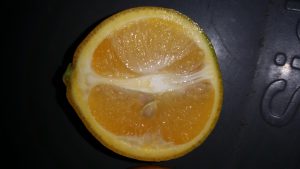
Another symptom of citrus greening is small, lopsided fruit that are often bitter. Photo credit: Erik Lovestrand
A team of plant pathologists, entomologists, and horticulturists at the University of Florida’s centers in Quincy and Lake Alfred and extension agents in the panhandle are now considering this new finding of HLB to help devise the most effective management strategies to combat this tiny invader in North Florida. With no silver-bullet-cure in sight, cooperative efforts by those affected are the best management practice for all concerned. Vigilance is also important. If you want to learn more about HLB and other invasive species contact your local UF/IFAS Extension office.














